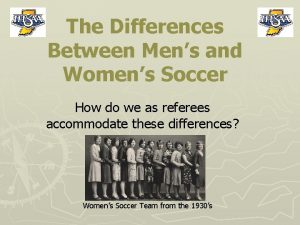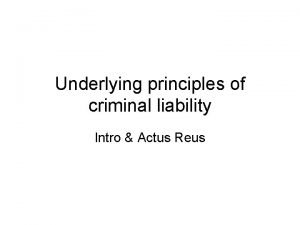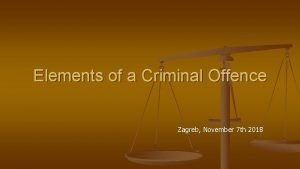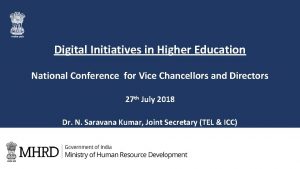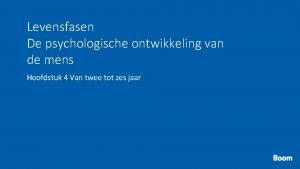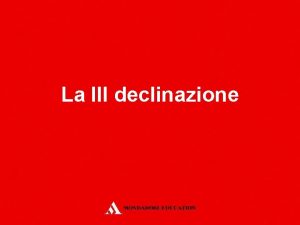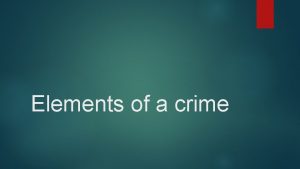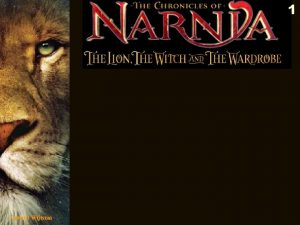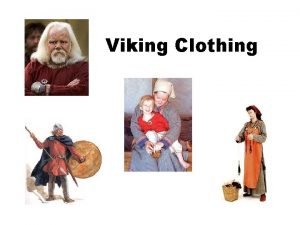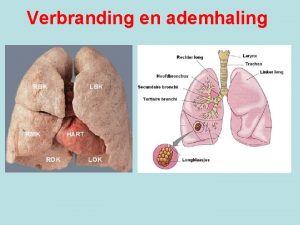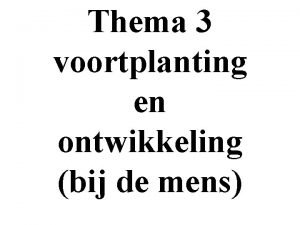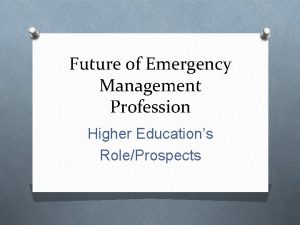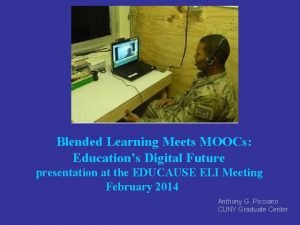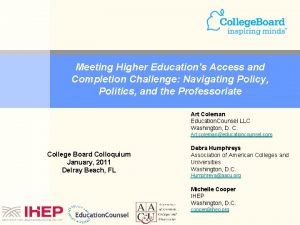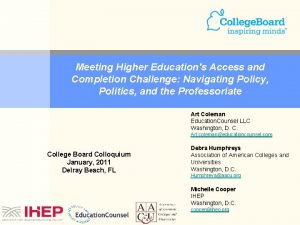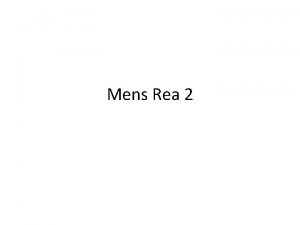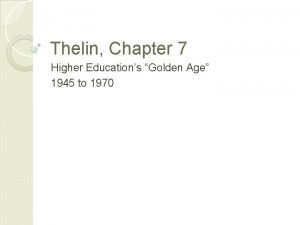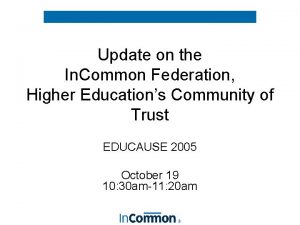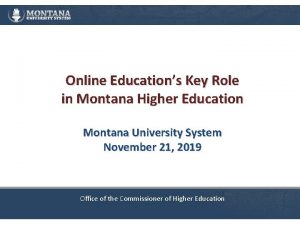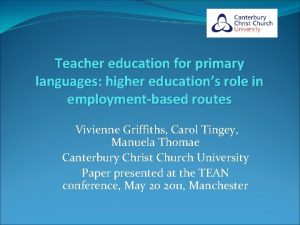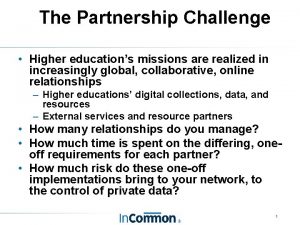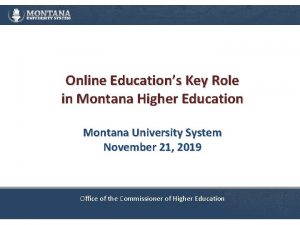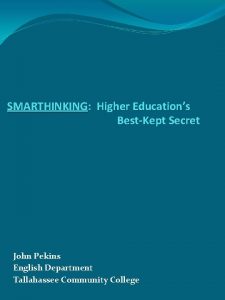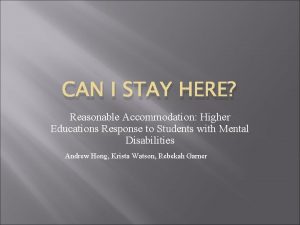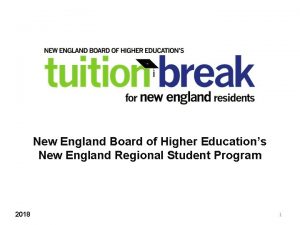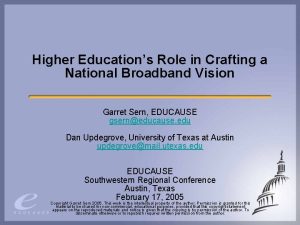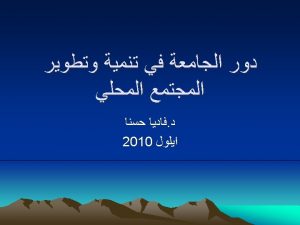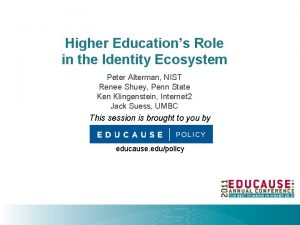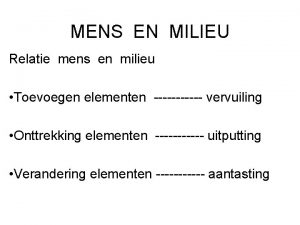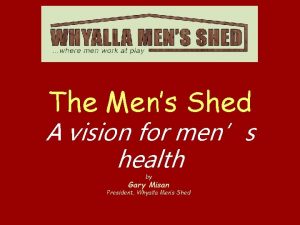Higher Educations Future The Digital University Mens and
![Higher Education’s Future: The Digital University “Men’s [and Women’s] courses will foreshadow certain ends…” Higher Education’s Future: The Digital University “Men’s [and Women’s] courses will foreshadow certain ends…”](https://slidetodoc.com/presentation_image/c07ad73f1a3984376827b8c8b160709f/image-1.jpg)
























- Slides: 25
![Higher Educations Future The Digital University Mens and Womens courses will foreshadow certain ends Higher Education’s Future: The Digital University “Men’s [and Women’s] courses will foreshadow certain ends…”](https://slidetodoc.com/presentation_image/c07ad73f1a3984376827b8c8b160709f/image-1.jpg)
Higher Education’s Future: The Digital University “Men’s [and Women’s] courses will foreshadow certain ends…” Drexel University Online | Online Learning Council January 22, 2019 Anthony G. Picciano Hunter College and Graduate Center - City University of New York 1

“There are more people in the world than ever before, and a far greater part of them want an education. The demand cannot be met simply by building more schools and training more teachers. Education must become more efficient. To this end curricula must be realized and simplified, and textbooks and classroom techniques improved. In any other field a demand for increased production would have led at once to the invention of labor-saving capital equipment. Education has reached this stage very late, possibly through a misconception of its task. Thanks to the advent of technology…These tools are finding their way into American schools and colleges. . . allowing each student to proceed at his own pace to receive immediate feedback to play an active role [where] there is constant interchange between program and student to have access to charts, maps, graphs, models…” Skinner, B. F. (1958). Teaching machines. Science, 128 , 969 -977. Sidney Pressey designed his own teaching machine in the 1920 s at Ohio State University. Edward Thorndyke developed the design for a teaching machine in 1912 at Teachers College. 2

Predicting what will happen in the future is easy. When it will happen is the hard part! 3

The Future of Higher Education Drew Faust, the president of Harvard University, in a message to the World Economic Forum in 2015, described three major forces that will shape the future of higher education: • the influence of technology • the changing shape of knowledge • the attempt to define the value of education. “So much of what humanity has achieved has been sparked and sustained by the research and teaching that take place every day at colleges and universities, sites of curiosity and creativity that nurture some of the finest aspirations of individuals and, in turn, improve their lives—and their livelihoods. As the landscape continues to change, we must be careful to protect the ideals at the heart of higher education, ideals that serve us all well as we work together to improve 4 the world. ” (Faust, 2015)

The Future of Higher Education Clayton Christensen, Harvard Business School Professor and author of The Innovator’s Dilemma, in 2017, during a speech at a Higher Education Summit, spoke at length about disruption theory broadly and discussed its application to colleges and universities. Higher education, he explained, was among the industries that "for several centuries was not disrupted, " but "online learning has put a kink in that. “ He predicted that half of American universities would close or go bankrupt within 10 to 15 years. He went on to say that “Technology itself is never the disruptor, a new business model is. But "it is technology that enables the new business model to coalesce, and that's what is happening in higher ed now. 5

Higher Education Enrollments 6

The Extent of Distance Education 7

How Did We Get to Here The Evolution of Online Education Timeline 1990 s 2000 2008 2014 -> The 1 st Wave The 2 nd Wave The 3 rd Wave The 4 th Wave ? 8 2

The 1 st Wave (Beginnings) – 1990 s • Technology – Slow-speed Internet • Model – Pedagogical – Asynchronous Learning Network (ALN)/Largely Text-Based • Key Players – Four-year Colleges and Universities, Community Colleges, and For-Profit Colleges with already established distance learning programs (i. e. , UMUC, Penn State World Campus, SUNY Empire State, APUS) For. Profits (i. e. , U of Phoenix) invest tens of millions of dollars into online education. . Enrollment – 100, 000 s of students enrolled each year in fully-online, for-credit courses – 1 million by 2000. 9

The 2 nd Wave (Blending Into the Mainstream) – Early 2000 s to 2008 • Technology – High-Speed Internet (Cable modems, DSL) • Model – Pedagogical - Blended Learning /Social and Multi-Media/Open Resources Evolve • Key Players – Mainstream Public Higher Education, Tuition-Driven Non-Profits, For-Profits, Global Enterprises. Enrollment – Millions of students enrolled each year in fully online, for-credit courses – 4+ million by 2008. 10

The 3 rd Wave (Massive Open Online Courses - MOOCs) – 2008 to 2013 • Technology – High-Speed Internet – Wi-Fi – Mobile Computing • Pedagogical Model – MOOC – Access/Cost Benefit Model/ Multi-Media Infused Open Source Expands • Key Players – Non-Profit Private Universities (Stanford, M. I. T. , Harvard). Venture capitalists and corporate-affiliated foundations spur MOOC development. MOOC companies – Udacity, Coursera, ed. X. Enrollment – Millions of students enrolled each year in credit and non-credit bearing courses. 5 million students enrolled in fully online for-credit courses in 2013. Millions more enrolled in blended courses. 11

The 4 th Wave (The Present)– 2014 ->2020 s • Technology – Super High-Speed Internet – Wi-Fi - Mobile Computing/Tablets – Cloud Computing • Model – Reconciliation of the 2 nd Wave Blended Learning Pedagogy & 3 rd Wave Access/MOOC Models PLUS I. Learning Analytics/Big Data II. Adaptive Learning/Differentiated Instruction/Personalized Learning III. Social Media – Mobile Technology IV. Open Sources/Learning Objects V. Gaming/MUVE. Key Players – All of education plus online learning companies funded by venture capitalists and corporate foundations. New Models - Western Governors, U of Southern New Hampshire, Purdue-Kaplan Partnership. Enrollment – Millions of students enrolled each year in credit and non-credit bearing courses. Over 6 million students were enrolled in fully online for-credit courses by 2016. Millions more enrolled in blended courses. 12

Theme for the 4 th Wave - One Size Will Not Fit All! • Different strokes for different folks. • Different types of schools will approach Online and Blended Learning and MOOC technology differently. • Different programs/disciplines/faculty will approach Online and Blended Learning and MOOC technology differently. • Different students will approach Online and Blended Learning and MOOC technology differently. 13

The 4 th Wave – 2014 -> 2020 s – Integrated Multimodal Model 14

The 4 th Wave – 2014 -> 2020 s - Integrated Multimodal Model Applied to a Self-Paced, Adaptive, Fully Online Course 15

The 4 th Wave – 2014 -> 2020 s - Integrated Multimodal Model Applied to a Teacher-Led, Fully Online Course 16

The 4 th Wave – 2014 -> Early 2020 s – Integrated Multimodal Model Applied to a Mainstream Blended Learning Course 17

The 5 th Wave – 2020 s → Online Learning Technologies Continue to Evolve and Augmented by 1. Nanotechnology -> Early Quantum Computing – billionths of a meter or the size of five carbon atoms -> subatomic size 2. Artificial Intelligence – Amazon Alexa/Apple Siri Will Evolve into Mobile Personal Assistants 3. Massive Cloud Computing – move from low cloud (i. e. email) applications to mission-critical applications (i. e. , financial, personnel, student databases, CMS/LMS)) 4. Low Cost/High Quality Digital Media and Animation – Lucasfilms Starwars: Rogue 1, 20 th Century’s Avatar 5. Conversion of non-instructional academic support, student counseling, and library services to mostly digital systems. Consolidation and centralization of administrative support services especially in the public sector. 6. Key Players – Higher education will see more mergers and partnerships. Rise of the mega-universities. Teaching -> Tutoring 18

2030 s and Beyond…. . New Technologies 1. Quantum Computing – subatomic-based technology 2. Computing and the Mind (Biosensing) Neuroprostheses Brain nets Nanobots 3. Superclouds – Watson + Big Brother 4. Robotics 5. Fully Developed Artificial Intelligence Applications including teaching and learning. 19

2030 s and Beyond…. . 20

What Do College Presidents Think about Higher Education’s Future? The Chronicle of Higher Education in a survey of college presidents (N=349) focused on the future of innovation in higher education. • Direction: Two-thirds of presidents of public institutions think that higher education is headed in the right direction, as do well over half of their private campus peers. • Modality: An overwhelming majority of presidents—three quarters at private institutions and even more at public campuses—think that blended courses that contain both face-to-face and online components will have a positive impact on higher education • Focus: Presidents say that when it comes to innovation in higher education, reformers pay too much attention to cutting costs and not enough to changing the model of teaching and learning. • Change drivers: Two-thirds of public-institution presidents think that politicians are the most influential drivers of change in higher education and half of privatecampus presidents agree with that assessment. The presidents on both types of campuses believe strongly that faculty should be the number one drivers of 21 change. 21

Challenge to Educators • Test / Experiment with the technology. • Use / Improve that which works. • Discard that which does not work. • Whatever you do, do not ignore it. 22

Final Thoughts! Stephen Hawking (Just before he passed way last year). “I think the development of full artificial intelligence could spell the end of the human race. Once humans develop artificial intelligence, it will take off on its own and design itself at an ever-increasing rate. ” Yuval Noah Harari (Author of Sapiens, in his latest book, 21 Lessons for the 21 st Century (2018). “What we are facing is not the replacement of millions of individual human workers by millions of individual robots and computers; rather, individual humans are likely to be replaced by an integrated network. ” Steven Strogatz, professor of mathematics at Cornell and author of the forthcoming Infinite Powers: How Calculus Reveals the Secrets of the Universe, in an op-ed in the New York Times in December 2018) On the rise of machine learning. By playing against itself and updating its neural network as it learned from experience, Alpha. Zero discovered the principles of chess on its own and quickly became the best player ever… Most unnerving was that Alpha. Zero seemed to express insight. It played like no computer ever has, intuitively and beautifully, with a romantic, attacking style. ” 23

Charles Dickens (1843) In A Christmas Carol by Charles Dickens, the miserly Ebenezer Scrooge is visited on Christmas Eve by the ghost of his former business partner Jacob Marley as well as the Ghosts of Christmases Past, Present, and Future. The visit to the future ends as Scrooge faces his own mortality in the form of a tombstone inscribed with his name. He asks the Ghost: “Before I draw nearer to that stone to which you point, answer me one question. Are these the shadows of the things that Will be, or are they shadows of things that May be. . ? ” The Ghost continued to point downward to the grave by which it stood. “Men’s courses will foreshadow certain ends, to which, if persevered in, they must lead, ” said Scrooge. “But if the courses be departed from, the ends will change. Say it is thus with what you show me!” (Dickens, 1843) 24

Thank You! Visit me at: anthonypicciano. com 25
 Pearson educations
Pearson educations Future continuous see
Future continuous see Future continuous and future perfect
Future continuous and future perfect Difference between mens and womens soccer
Difference between mens and womens soccer Actus rea
Actus rea Nedrick 1986
Nedrick 1986 Mens rea and actus rea
Mens rea and actus rea Future continuous future perfect exercises
Future continuous future perfect exercises Summary of past and present
Summary of past and present Future plans and finished future actions
Future plans and finished future actions Future perfect future perfect continuous
Future perfect future perfect continuous Kondicional 1 engleski
Kondicional 1 engleski Digital initiatives in higher education
Digital initiatives in higher education Gartner digital transformation in higher education
Gartner digital transformation in higher education Thermosensoren lichaam
Thermosensoren lichaam Mens shed insurance
Mens shed insurance Levensfasen de psychologische ontwikkeling van de mens
Levensfasen de psychologische ontwikkeling van de mens Declinazione eques equitis
Declinazione eques equitis Actus rea
Actus rea Actus rea
Actus rea Bunbury mens shed
Bunbury mens shed Mens impletur gratia
Mens impletur gratia Narnia half geit
Narnia half geit Viking dress code
Viking dress code Restvolume longen
Restvolume longen Voortplanting mens
Voortplanting mens



